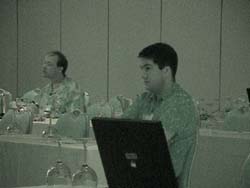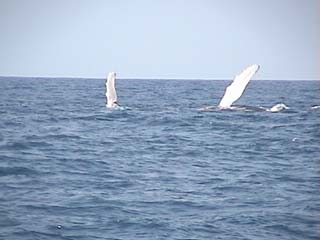Pacific
Symposium on Biocomputing
January 7 Report

There are only morning sessions today. It always
seems that no one likes to talk the last day. Lots of people have left
early to save a little money. But the ones who stayed got to listen to
some pretty interesting talks.
The first set dealt with approaches linking human
genotypes to phenotypes. Peter Park from Harvard discussed work analyzing
the gene expression patterns of 23 patients with ALL and 11 with AML. They
examined 7129 probes for 6817 human genes, using a scoring function that
would help them find genes expressed in one group but not in the other.
They found one gene, Zyxin, which was perfect. It was not expressed at
all in any of the ALL patients but was found at high levels in all AML
patients.
His nonparametric scoring function is pretty straightforward
and I hope I can do it justice. All the patients in one group get assigned
a 0. Those in the other get assigned a 1. They then determine the expression
levels for each gene in each group. They order all the expression levels
from low to high, with each of these still coupled with either a 1 or a
0. To get the score, the expression levels are shuffled around until all
the 1s are back together, counting how many steps it takes. So any gene
with a score of 0 means all the patients in one group express the gene
at lower levels than all the patients in the other group. A score of 0
will be selective for one group of patients. Pretty neat. Zyxin had a score
of 0.
Atul Butte from Children's Hospital in Boston
had a very intriguing presentation. They examined the gene expression patterns
from 6 patients that showed glucose intolerance but did not have diabetes.
They used two Affymetrix microarrays examining 35714 ESTs. They compared
the gene expression levels of the same patients on the two chips. Not too
surprisingly, genes that expressed at low levels showed greater intra-array
differences than genes expressed at higher levels. At low expression levels
the inherent noise in the assay is a greater proportion of the values than
at higher expression levels.
But what was really interesting occurred when
they compared the fold-change in expression levels between pairs of patients
on the two chips. Graphing the fold differences from each chip comparing,
say, patient 1 and patient 2 showed some real problems. In an ideal world,
you would expect that a gene that expressed, say, 5-fold better in patient
1 on the first chip, would also express 5-fold better on chip 2. Graphing
all 35714 ESTs should give a straight line. In a perfect world. In the
real world it gave a circle. That is, some genes were 10-fold higher in
patient 1 on the first chip and 10-fold lower on chip 2. Others were the
reverse.
The pairwise comparison of every 2 patients revealed
the same thing. So Butte worked out several approaches to statistically
identify which ESTs had a really significant difference in expression levels.
Here
is a link to the paper. It was pretty interesting and a nice presentation
of a difficult problem.
 The
last session looked at Phylogenetics in the Post-Genome Era. This one had
several discussions on developing better algorithms for generating phylogenetic
trees. While useful, all of these were pretty specialized
The
last session looked at Phylogenetics in the Post-Genome Era. This one had
several discussions on developing better algorithms for generating phylogenetic
trees. While useful, all of these were pretty specialized  (i.e.
looking at Drosophila species or HIV-1 variants). Eben made it though the
last talk. But Randy and I were dozing off well before that one ended.
(i.e.
looking at Drosophila species or HIV-1 variants). Eben made it though the
last talk. But Randy and I were dozing off well before that one ended.
The talks were over at 12, so I took the afternoon
off and went out on a sailing canoe to look for whales. The humpback whales
migrate into Hawaiian waters this time of year. They give birth to calves
and mate. Maui is the hot spot for tourists to go whale watching. I know,
having done it several times. There are a ton of boats that just follow
the whales around in the Maui Channel. It is pretty crowded and, even though
most tours try to obey the non-nuisance laws, I always felt the whales
deserved a little privacy.
 Well,
the Big Island has just as many whales, probably trying to get away from
all the boats around Maui. So, I went out on this authentic Hawaiian sailing
canoe. Made by hand from hawaiian koa trees by the captain, Casey Cho.
With fishing lines trolling behind us, we ventured out, and quickly came
upon a mother and her youngster slapping their pectoral fins on the water.
We watched for half an hour and then came upon another 2 whales who were
playing with each other by breaching. We sat out there, on this wooden
canoe, a couple of miles off shore, in the sunshine, just rolling with
the waves, eating pineapple and watching whales. It was a beautiful coda
to a wonderful meeting.
Well,
the Big Island has just as many whales, probably trying to get away from
all the boats around Maui. So, I went out on this authentic Hawaiian sailing
canoe. Made by hand from hawaiian koa trees by the captain, Casey Cho.
With fishing lines trolling behind us, we ventured out, and quickly came
upon a mother and her youngster slapping their pectoral fins on the water.
We watched for half an hour and then came upon another 2 whales who were
playing with each other by breaching. We sat out there, on this wooden
canoe, a couple of miles off shore, in the sunshine, just rolling with
the waves, eating pineapple and watching whales. It was a beautiful coda
to a wonderful meeting.
I'll be flying home tomorrow and getting in late.
This turned out to be a very exciting meeting and I hope these reports
have been useful. Let me know how you liked them. I really had a great
time writing them. I learned a lot about digital photos and movies. And
about remote access. And a little bit about alignment algorithms, torsional
stress of DNA, the draft sequence of the human genome, high performance
computing, the generation of genetic networks, and the problems associated
with analyzing array data. But I am looking forward to getting home. Sleeping
on hotel beds is never as nice as one's own. Aloha.
 The
last session looked at Phylogenetics in the Post-Genome Era. This one had
several discussions on developing better algorithms for generating phylogenetic
trees. While useful, all of these were pretty specialized
The
last session looked at Phylogenetics in the Post-Genome Era. This one had
several discussions on developing better algorithms for generating phylogenetic
trees. While useful, all of these were pretty specialized  (i.e.
looking at Drosophila species or HIV-1 variants). Eben made it though the
last talk. But Randy and I were dozing off well before that one ended.
(i.e.
looking at Drosophila species or HIV-1 variants). Eben made it though the
last talk. But Randy and I were dozing off well before that one ended.

 Well,
the Big Island has just as many whales, probably trying to get away from
all the boats around Maui. So, I went out on this authentic Hawaiian sailing
canoe. Made by hand from hawaiian koa trees by the captain, Casey Cho.
With fishing lines trolling behind us, we ventured out, and quickly came
upon a mother and her youngster slapping their pectoral fins on the water.
We watched for half an hour and then came upon another 2 whales who were
playing with each other by breaching. We sat out there, on this wooden
canoe, a couple of miles off shore, in the sunshine, just rolling with
the waves, eating pineapple and watching whales. It was a beautiful coda
to a wonderful meeting.
Well,
the Big Island has just as many whales, probably trying to get away from
all the boats around Maui. So, I went out on this authentic Hawaiian sailing
canoe. Made by hand from hawaiian koa trees by the captain, Casey Cho.
With fishing lines trolling behind us, we ventured out, and quickly came
upon a mother and her youngster slapping their pectoral fins on the water.
We watched for half an hour and then came upon another 2 whales who were
playing with each other by breaching. We sat out there, on this wooden
canoe, a couple of miles off shore, in the sunshine, just rolling with
the waves, eating pineapple and watching whales. It was a beautiful coda
to a wonderful meeting.